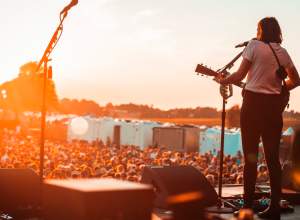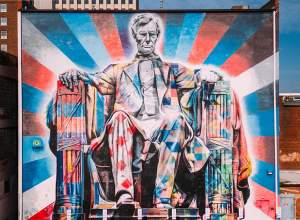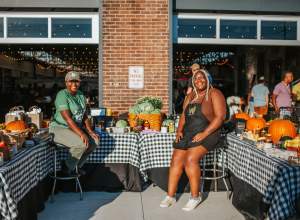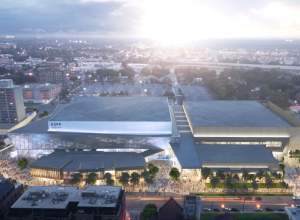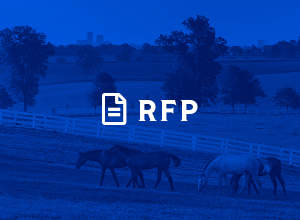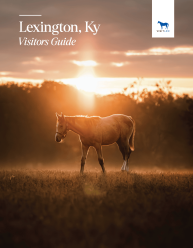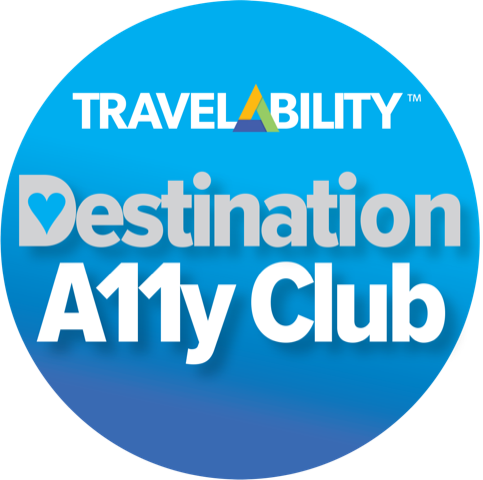Which city is considered the Horse Capital of the World? Surrounded by over 400 horse farms, Lexington is the Horse Capital of the World because...
- Lexington, Kentucky, had the honor of being the first city outside of Europe to ever host the World Equestrian Games. Attendance at the Alltech FEI World Equestrian Games in 2010 topped half a million. A record twenty-seven teams competed in eight disciplines. Fifty-eight countries were represented with 632 athletes and 752 horses. Of the 507,000 tickets sold, 70 percent went to non-Kentuckians.
- Lexington is home to the 1,200 acre Kentucky Horse Park which attracts almost a million visitors a year. Dedicated to all breeds of horse, nowhere else in the world can you see so many breeds in one place. A working farm, the Kentucky Horse Park features the popular parade of breeds called "Horses of the World", the Mare and Foal Show, a stunning film presentation of "Rein of Nobility", several museums, the Hall of Champions and much
 much more.
much more. - The water that passes through the massive limestone shelf that lies beneath our nourishing bluegrass pastures feeds the soil and grasses that grow strong horses unlike anywhere else in the world. The high mineral content in the soils of the Bluegrass Region leads to stronger bones and greater durability in horses and helps maintain our reputation as Horse Capital of the World.
- Keeneland Race Course, minutes from downtown, is arguably the most beautiful race course in the world. Keeneland hosts live race meets in the spring and fall. In 2009, the Horseplayers Association of North America introduced a rating system for 65 Thoroughbred racetracks in North America. Keeneland was ranked #1.
- The best equine care facilities in the world are located here, helping to solidify our place as Horse Capital: Rood & Riddle (tours by appointment) and Haygard, Davidson and McGee are both located here in addition to the Gluck Equine Research Center.
- On any given day, you will find around 1,000 horses in residence at The Thoroughbred Center where the champions of tomorrow are in training. An integral part of Kentucky's world-famous Thoroughbred industry, this is where future racing champions come to learn how to behave like a race horse. Tours are available.
- As you would expect in the Horse Capital of the World, many champions make their home in Lexington. Kentucky Derby winner Go for Gin, and Standardbred Pacers Western Dreamer and Staying Together all live at the Kentucky Horse Park. Other past Derby winners reside on farms in the area. Old Friends at Dreamchase Farm, home to many superstars who are treated like royalty, offers daily tours.
- Calumet Farm, with a record history of Kentucky Derby and Triple Crown winners that continues to be unmatched worldwide, is located in Lexington, two minutes from the Blue Grass Airport.
- Lexington has produced the most legendary horses in the world. One such horse, Man o' War, has a memorial, just outside the Visitors Center at the Kentucky Horse Park.
- Isaac Murphy (born 1861) lived in Lexington. This African-American jockey competed in eleven Kentucky Derbys, becoming the first jockey to win three Derbys.
- International Museum of the Horse is located in Lexington. This museum traces the 50-million-year history of the horse with one of the most comprehensive educational and historical collections in the world. It has hosted such block buster exhibitions as "Imperial China", "All the Queen's Horses" and "A Gift from the Desert", exploring the relationship between man and horse in three distinctly different cultures.
 Lexington is Horse Capital of the World in part because more money changes hands over the sale of horses in Lexington than any place in the world. It is not at all uncommon for horses to fetch millions of dollars at the annual Keeneland Sales. Keeneland is the world's largest and most prestigious Thoroughbred auction company.
Lexington is Horse Capital of the World in part because more money changes hands over the sale of horses in Lexington than any place in the world. It is not at all uncommon for horses to fetch millions of dollars at the annual Keeneland Sales. Keeneland is the world's largest and most prestigious Thoroughbred auction company.- Thoroughbred Park, a fitting tribute to this noble breed, is located in downtown Lexington. People can relax and ponder the grand bronze horse sculptures, including an entire race frozen just before the finish line.
- The largest outdoor Saddlebred horse show in the world is held here in Lexington at The Red Mile: The Junior League Horse Show has been held there each summer for more than 70 years.
- The Keeneland Library, one of racing's most valuable assets, contains more than ten thousand volumes plus an extensive collection of photo negatives, newspaper clippings and other historical documents.
- Horsey gifts are readily available at the Keeneland Shop, the Kentucky Horse Park Gift Shop, and the American Saddlebred Museum Gift Shop, the Lexington Visitors Center in The Square, L.V. Harkness, many of the shops at Lexington Center, and at the area's many tack and riding apparel shops.
- The best equine vets are in Kentucky, as you might expect. There are more than 16 clinics specializing in horse health.
- Lexington is home to the second oldest horse racing track in the nation: The Red Mile Harness Track.
- From Lexington, group or private working horse farm tours are available daily, year round. Five companies currently offer regular van tours of horse country. Touring a private horse farm is one the most popular activities with visitors to our region. There are many ways to book, including www.visithorsecountry.com.
- Beginning riders can experience horseback riding at the Kentucky Horse Park, Big Red Riding Stables, Deer Run Stables, Sugar Creek Resort or Whispering Woods. More experienced riders may want to check out the Sunburst Horsemanship School, Kenridge Farm or the Life Adventure Center of the Bluegrass. If you have your own horse, you can ride at Hisle Park, 3655 Briar Hill Road.
- Year round, you can watch horses in training. Daily morning workouts at the Keeneland Race Course (free) and the Thoroughbred Center ($15) are open to the public.
- One of the most beautiful drives in the U.S. is out Old Frankfort Pike with historic horse farms and miles of plank and stone fences. If you only have a short time, this is one of the best drives to get a glimpse of our legendary landscape.
- The Lexington Convention and Visitors Bureau's most popular map for touring our region is a large format annotated map allowing visitors to drive through Horse Country at their leisure. The map is free. It points out well known horse farms as well as other points of interest along the route.
- Breyer Horses created a limited edition Breyer model horse based on Big Lex, Lexington's famous blue horse. (They are for sale at the Visitor Center.)
- Lexington is home to the largest collection of Saddlebred artifacts in the world including trophies, photographs, tack and artwork at the American Saddlebred Museum. There is also a library of over 2,400 volumes used for bloodline and genealogical research. The American Saddlebred is Kentucky's oldest native breed.
- United States Equestrian Federation is located in Lexington.
- The great Thoroughbred stallion named Lexington was born here. He was the fastest runner and the greatest sire of his time in mid-1800's and had a profound impact on the breed and the industry. By the way, the horse was named for the city....not the other way around!
- What other city would dare to use a stunning blue horse as a symbol of the beauty of our region and the horses that made us known around the world?
- There are more than 450 horse farms nurturing champion horses of all breeds in the Bluegrass region.
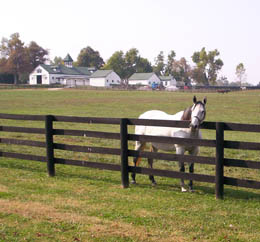 Great jockeys Don Brumfield, Steve Cauthen and Woody Stephens are all from the Bluegrass region.
Great jockeys Don Brumfield, Steve Cauthen and Woody Stephens are all from the Bluegrass region.- The jockey that rode Aristides to victory in the very first Kentucky Derby, Oliver Lewis, was born in 1856 in Fayette County.
- The world's only five breed hitch will be found in Lexington at the Kentucky Horse Park. This hitch usually includes representatives of the following breeds: Shire, Belgian, Clydesdale, Percheron, and Suffolk.
- There is one horse for every 12 people in Kentucky. In 1789, there were more horses than people in Lexington.
- Best equine transport companies are located here.
- Horse breeding has been an important Bluegrass industry since the area was first settled. Daniel Boone himself introduced a bill for "improving the breed of horses" at Kentucky's first legislative assembly.
- It is said that more streets and highways here are named after horses and race tracks than any place in the world. Just a tiny sampling:
- Citation Boulevard was named after a bay colt bred at the Calumet Farm, who won the 1948 Triple Crown and raced for seven years earning over $1 million.
- Pink Pigeon Parkway was titled after a seven-time stakes-winning filly.
- Sir Barton Way was named after the first Triple Crown winner in 1919.
- Star Shoot Parkway was titled after a sire of Sir Barton and 181 other stakes winners.
- Bold Bidder Drive was named after the sire of 1979 Kentucky Derby winner Spectacular Bid.
- Aristides Boulevard was named after the first Kentucky Derby winner in 1875.
- The main urban arterial circling Lexington to its south, Man o War Boulevard, is named after one of the greatest thoroughbred racehorses.
- Pimlico Parkway is named after the famous track in Baltimore and Beulah Park is named after Ohio's home for thoroughbred racing.
- The National Horse Center is located here in Lexington, KY. It is a collection of more than 30 national, regional and state equine associations, commissions and organizations. The Kentucky Thoroughbred Association, The Pyramid Society, the American Hackney Horse Association, the American Hanoverian Society, U.S. Pony Clubs, Inc., and many more are part of the ever-growing equine "village," located on the grounds of the Kentucky Horse Park.
- The Kentucky Derby with an attendance of about 140,000 is held in Louisville. Louisville may have "the race", but Lexington has "the reason for the race". This is where the best race horses are born, bred, trained, raced--and retired. Many people choose to stay in Lexington when attending the Derby. Others attend the largest Derby party in the world at Keeneland Race Course.
- Through today, from Aristides, first Derby winner in 1875, to 2013 Kentucky Derby winner Orb, more than 80 percent of Derby winners were born in Kentucky.
- Our area's central role in the Thoroughbred industry began during the Civil War, when horse breeders in Maryland, the Carolinas and Virginia moved their horses "west" for safety. Their horses thrived in the Bluegrass, thanks to mineral content of the soil, the gently rolling terrain and the favorable weather conditions. By the 1930s, the Lexington Herald-Leader had a standing offer to give subscribers free papers on any day that no horse bred within a 50-mile radius of Lexington won a race at a major track - an event that no one can remember ever happening.
- You'll find top equine programs at the University of Kentucky, Midway College, and
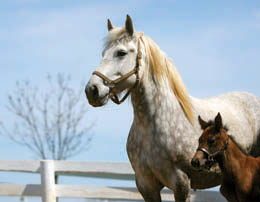 Georgetown College.
Georgetown College. - The estimated economic impact of Kentucky's horse economy is $4 billion annually. Only in the Horse Capital of the World would you expect to find such astonishing figures!
- The Rolex Kentucky Three Day Event is held in Lexington. It is one of the top 3 annual equestrian eventing competitions in the world.
- Lexington is home to the official registry of all Thoroughbred horses world wide, The American Stud Book kept by The Jockey Club.
- The Kentucky horse industry is responsible for nearly 80,000 direct and indirect jobs, from grooms to administrative support staff to veterinarians.
- Lexington native Henry Clay, American statesman and orator, was one of the most respected breeders and scientific farmers of his time. He introduced Hereford Cattle to the United States and became one of the most successful providers of mules to the South. He was also a horseman and lover of racing. His prominence as a political figure and his success as a breeder helped to launch Lexington's reputation as Horse Capital of the World. His estate is open to the public.
- Maker's Mark Secretariat Center, a national resource for the adoption of thoroughbreds, is on the grounds of the Kentucky Horse Park.
- The horse industry is Kentucky's number two agricultural cash crop, based on cash receipts from farm commodities. (By the way, horses don't even show up in the top ten for Florida!) Source: USDA
- Deloitte & Touche sites the number of horses in Kentucky at 320,000.
- Prisoners help care for retired thoroughbreds at Blackburn Correctional Facility (part of the Thoroughbred Retirement Foundation Group).
- This region is committed to taking care of retired race horses. There are 13 Equestrian Retirement Facilities in Kentucky.
- Most of the living Kentucky Derby winners are stabled at the beautiful farms surrounding Lexington.
- Because Phil Vettel, Food Critic for the Chicago Tribune thinks so.
- The prestigious National Horse Show is now named the Alltech National Horse Show and is hosted at the Kentucky Horse Park.
- If there is any doubt in your mind that Lexington is the true Horse Capital of the World, just look out the window next time you fly in to Blue Grass Airport.
- Lexington is home to the National Reining Championship, held at the Kentucky Horse Park...another great event that demonstrates that the Horse Capital of the World is not only about Thoroughbreds.
- The North American Racing Academy, an accredited college in Lexington, Kentucky, offers the only college degree program in the United States focused on producing jockeys.
- The revolutionary weekend event "Road to the Horse" is now presented in Lexington. Expert horse trainers have just 3 hours to break untouched horses to ride - in front of a crowd of thousands.
- The resources, history, and love of horses that exudes from the entire Lexington area was the inspiration for Asbury University's Equine Center. The university's Equine Management major is one of Asbury's top three majors.
- We rank #1 in number of acres dedicated to the Equine industry. Read about that, and other interesting statistics about Lexington and Fayette County.
- The Horse Capital of the World will go down in history as the site of American Pharoah's grand slam win at Breeders' Cup 2015 at Keeneland Race Course. And where does American Pharoah live now? At Ashford Stud, located in the heart of Kentucky's famous Bluegrass, just minutes from downtown Lexington!
Have another good reason why Lexington is the Horse Capital of the World? Email vacation@visitlex.com.
